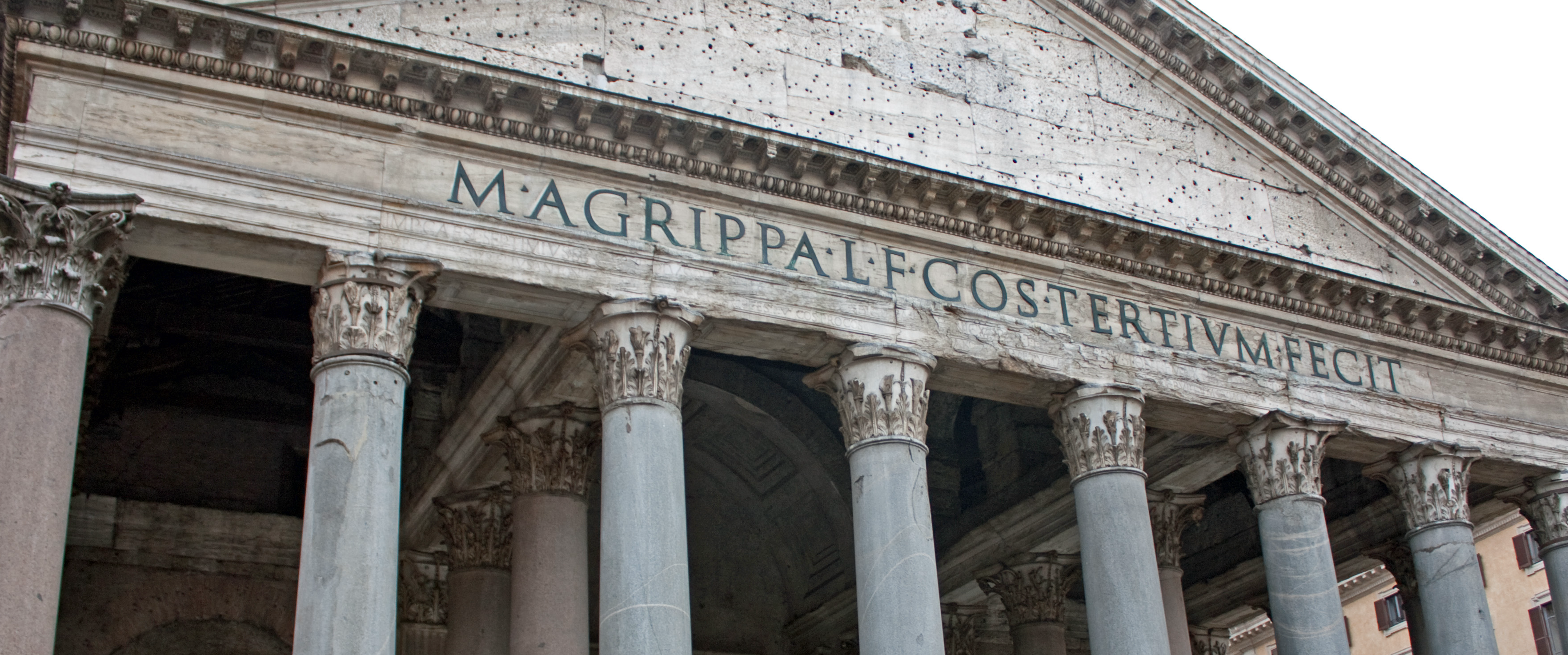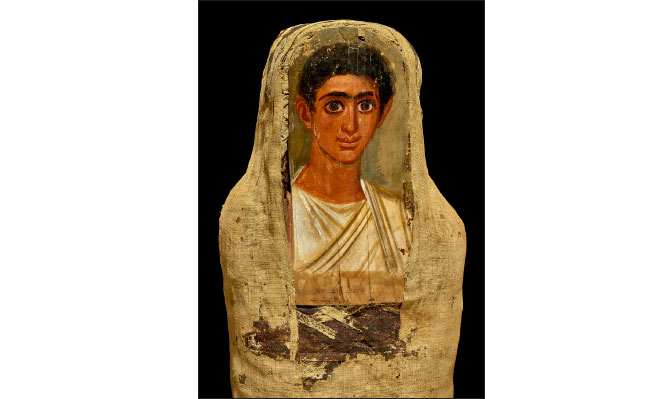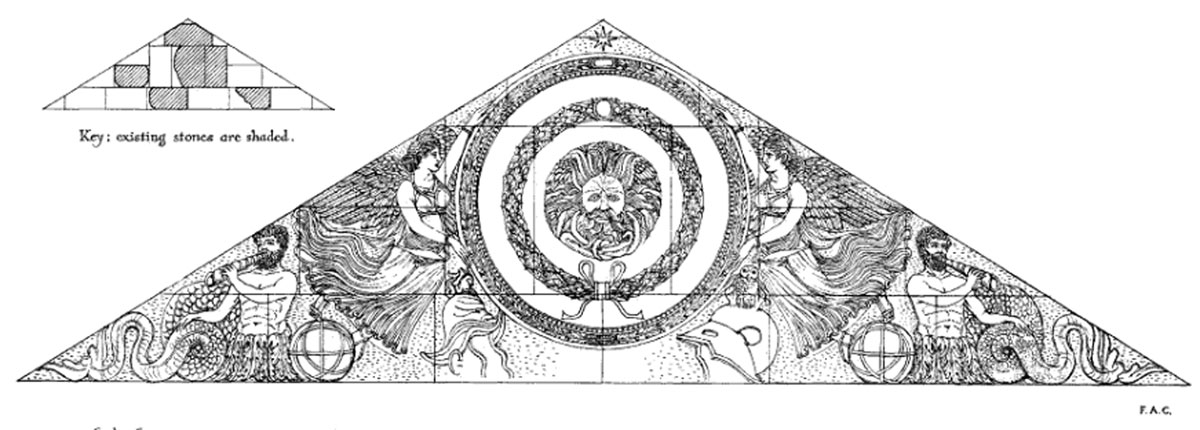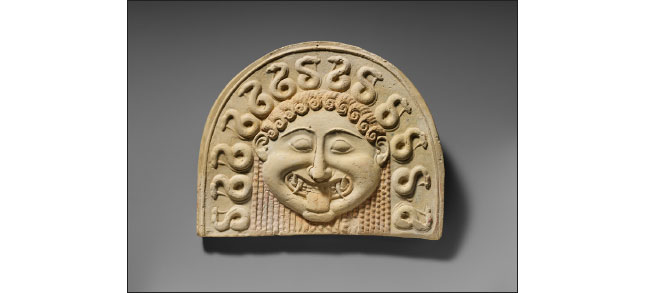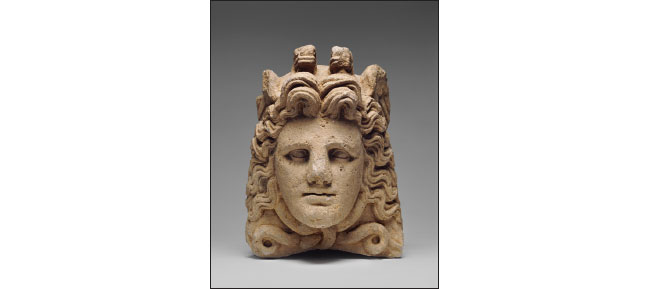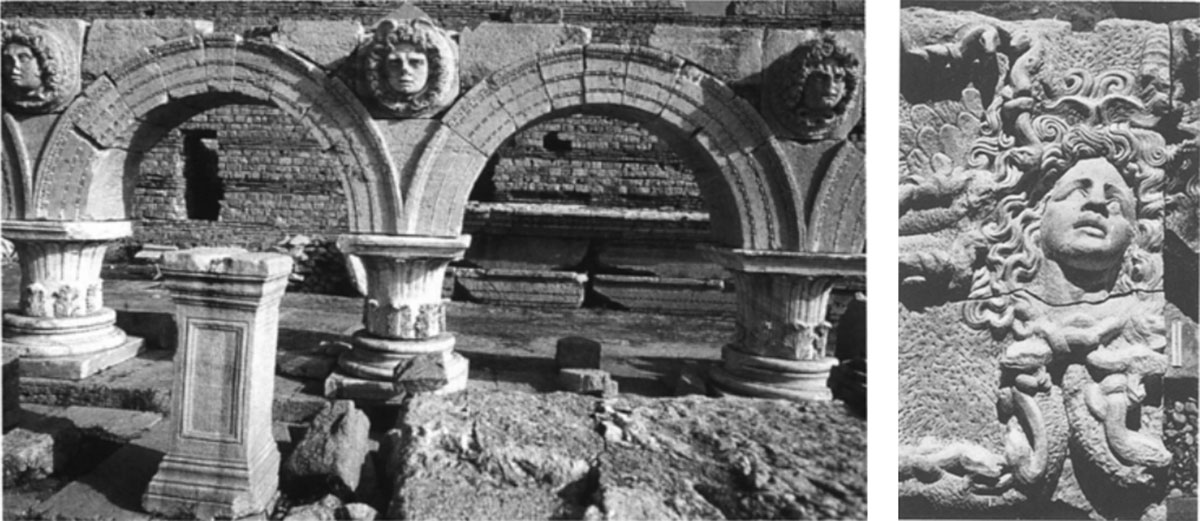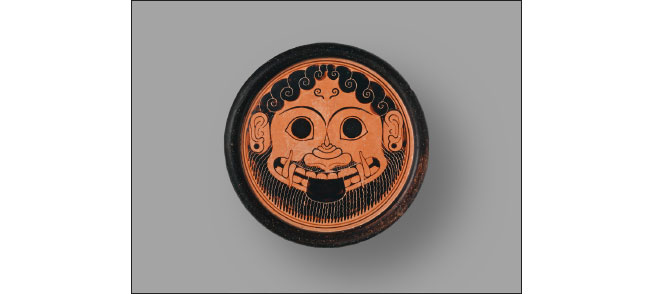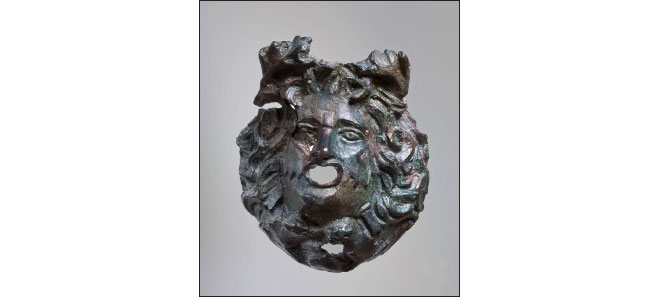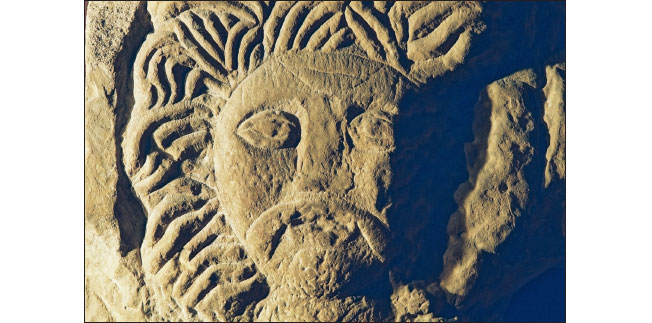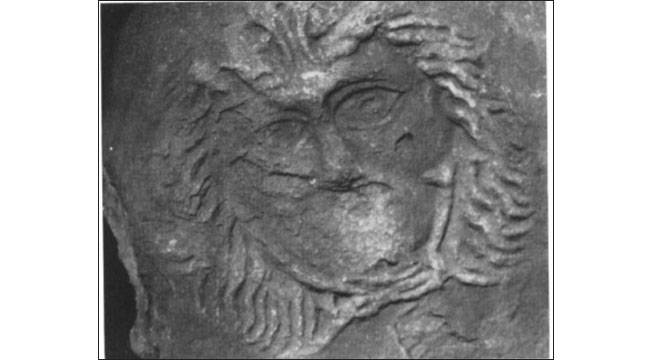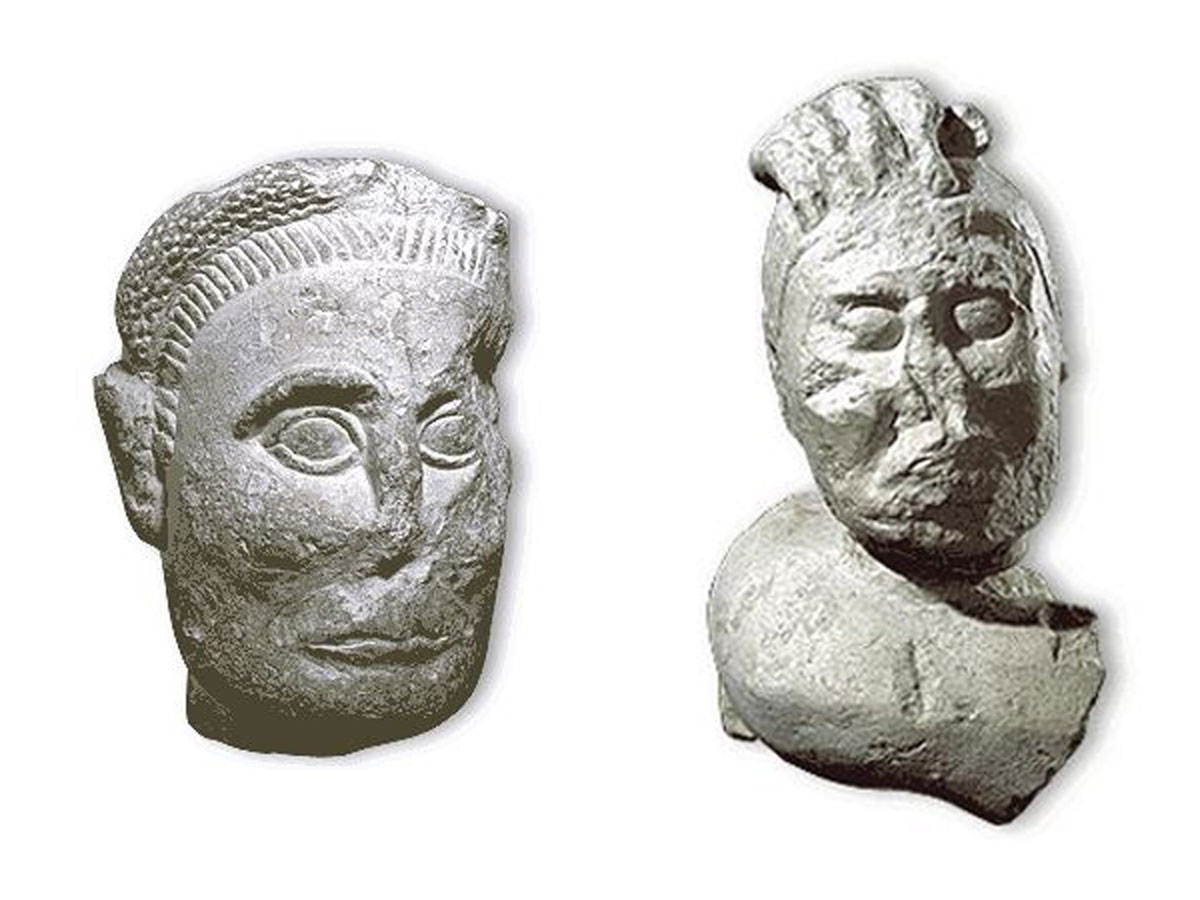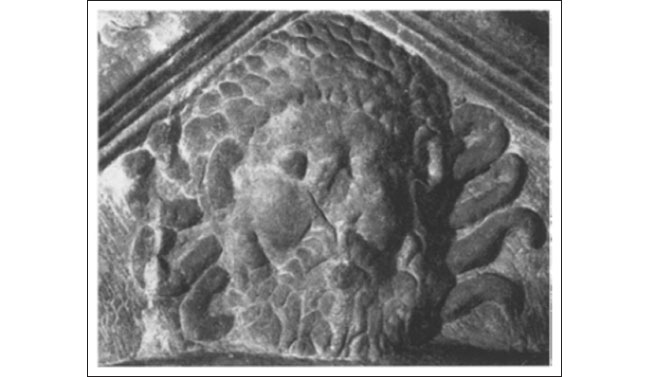Introduction
This article considers whether the concepts of Globalisation and Glocalization can shed new light on art in Roman Britain. I argue past theories’ explanations for differences in the depiction of Classical elements in Romano-British art (i.e., failure to emulate the Classical style (Romanization); an attempt to express their identity beneath a repressive regime (Creolization); or an unconscious mixing of two cultures (Hybridization)) were insufficient, and instead I argue ‘globalized’ motifs—motifs recognizable across regions of the Empire—were ‘glocalized’ by indigenous artists to fit into their pre-existing cultures and local needs. I use the depiction of the Medusa/Gorgon in stone sculpture as a case study, and will ask the following questions: How does the visual language differ from Mediterranean examples? Is the subject matter used in the same contexts as Roman examples or in new contexts, and if so, how and why? Considering cultural tradition and art in the immediate region of Britain and neighbouring Gaul may give insight into why the Gorgon changed when transferred into Roman Britain, most notably why it is depicted as male in Romano-British sculpture.
This article is structured in three parts. First, a literature review giving a brief overview of the development of Romanization, subsequent theories attempting to replace it, and more recent exploration of Globalisation theory. The second section is a broad overview of the depictions of Medusa in sculpture from the Roman Mediterranean. The third is an exploration of the Gorgon in Romano-British sculpture and an examination of cultural elements that may have caused the Gorgon to ‘glocalize’ in certain ways. I will also make the final point that when the word ‘global’ is used throughout this article, one should read ‘Roman’, ‘Mediterranean’ or ‘Classical’.
Globalization and Glocalization in archaeology
The term ‘Globalization’ dates back to the 1930s, but largely came to the forefront of the minds of academics and non-academics alike in the 1990s, seeping into rhetoric across multiple disciplines. Archaeology has been no exception—since the early 2000s archaeologists have increasingly drawn on Globalization as a way of thinking about interconnectedness (e.g. Hingley 2005). Globalization is a messy term. Definitions vary by discipline, and it has been reinterpreted each time it entered a new academic tradition (Pitts and Versluys 2014: 11). In the realm of politics and economics, Globalization is treated as a relatively recent development of the modern world. For example, American Economic History: A Dictionary and Chronology defines Globalization as,
‘The process of international integration developing from the increased shared views, ideas, products, and culture created by advances in tele-communications and transportation in the late twentieth and early twenty-first centuries…’ (Olson and Mendoza 2015: 269).
Disciplines focused on the present and recent past tend to view the process we call Globalization as a product of the nineteenth, twentieth, and twenty-first centuries, however, in a cultural context at least, this may be short-sighted. Roman writers saw themselves as living in a newly interconnected world. For example, in the second century BC, Polybius (Histories 1.3) wrote,
‘Previously the doings of the world had been … dispersed, as they were held together by no unity of initiative, results, or locality; but ever since this date history has been an organic whole, and the affairs of Italy and Libya have been interlinked with those of Greece and Asia, all leading up to one end’.
This text suggests Romans viewed the economic and cultural interconnectedness of their world in a comparable way to how we describe our own interconnected world.
Within Roman archaeology, Pitts and Versluys (2014: 11) define Globalization as ‘processes by which localities and people become increasingly interconnected and interdependent’ and note amongst varying definitions ‘common denominators … are increasing connectivity and de-territorialisation’. Pertinent to this article is how Globalization theory attempts to break from previous ways of interpreting the transfer of ideas and material culture within the Roman world. Past interpretations stemming from concepts like Romanization and acculturation make oversimplified assumptions about the presence of ‘foreign’ material culture at a given site in ways that reinforce anachronistic national boundaries. To borrow Versluys’ (2014a: 150) example of the Fayum portraits of Egypt (Figure 1):
‘The people buried this way were neither ethnically half-Roman/half-Egyptian, nor were they looking for a Roman and/or Egyptian identity. They had themselves portrayed the way elites had themselves portrayed all around the Mediterranean … and they were buried the Egyptian way. In the same period, an ethnic Syrian living in the Fayum could be buried like this’.
Contrary to ideas about acculturation, the presence of elements from culture x in society y does not mean that the material was a possession or product of one who is ethnically x or that they had a desire to emulate culture x. In the context of this article, pieces in a Classical style were not designed for ‘ethnic’ Romans, nor were pieces with La Tène features designed for ‘ethnic Britons’. Material culture is not necessarily tied up with ethnic, national, or cultural identity as it has been interpreted in the past. Rather, styles moved and attained new meanings independent of their origin culture (Versluys 2014a: 146). In a globalized ‘world’, homogeny does not take over. Rather, some elements of culture are universalized and then ‘particularization’—what has been dubbed Glocalization—takes place in local contexts (Versluys 2014: 155). In this way, cultures within a ‘globalized’ realm like the Roman Empire ‘were no longer taxonomic, but largely had become interactive and refractive’ (Versluys 2014: 163).
Glocalization refers to when a cultural element becomes recognisable cross-culturally on a global scale, and then takes on new particularities within different localities. It is when the iconography and function of a Roman (global) god changes according to local traditions and needs. Rodoumetof (2016: 403) described this process as a ‘refraction of globalization through the local’. The global passes through the local and, like light through a prism, ‘radiate[s] a spectrum of differences’ thus creating at once heterogeneity and homogeneity (Roudometof 2016: 399). The introduction of Glocalization has encouraged scholars to zoom in on how a ‘global’ object or motif takes on new characteristics in a local context. Van Alten (2017: 147) argues Glocalization provides a perspective on material culture that does not rely on a bottom-up or top-down process. The material culture of the Roman provinces shares characteristics seen throughout the Empire ‘which makes it trans-locally recognizable,’ yet ‘locally different’. Roman and indigenous cultures were not static, unchanging entities before conquest, thus treating them as ‘coexisting’ entities is insufficient. Rather, interaction allowed for the creation of new cultures where ‘both local and global interests’ united (van Alten 2017: 147 calling on Van Andringa 2002; 2007). Unlike other frameworks, Glocalization allows room for the agency of local people and recognizes the varied ways Globalization occurs across the Roman world (Guidetti and Meinecke 2020: 25). Glocalization furthers Globalization in an important way: it hones in on how ‘global’ motifs change according to localities they come into contact with, as will be seen in the sculpture considered below, and allows the consideration of two or more contexts that may have lead to new interpretations of pre-existing motifs.
If Globalization theory is a helpful tool for studying cultural change in the Roman Empire, then it should help gain better insight into the artefacts. Romano-British sculpture in particular has been notorious amongst scholars for being considered especially poor quality relative to other provincial art, often interpreted as failed attempts to emulate the realistic Classical sculpture of their Roman rulers (Collingwood and Myres 1936: 249–250). I argue, however, Romano-British artists were in fact taking Classical subjects and interpreting them in their own ‘glocalized’ way, creating something neither fully Roman nor fully British, but rather a new creation that is Romano-British. For this article, I have focused on the interpretation of the Romano-British Gorgon in stone sculpture, largely due to long-time confusion amongst scholars over its unusual depiction as male in Roman Britain.
Romanization to Globalization
Romanization was the dominate lens through which Roman Britain was studied from the early 1900s until the 1950s to 1970s, when the breaking up of modern-day empires led scholars to consciously attempt to depart from it (Hingley 2014a: 6373). The theory of Romanization which developed out of Haverfield’s (1912) work operated on the assumption that progression from ‘primitive’ to ‘civilized’ was inevitable and steady (Hingley 2014a: 6373). Consequently, this would lead to an empire that was uniformly Roman. In the case of provincial sculpture, this did not satisfy researchers long when faced with vast variety in style. Variety appears to be the major source of friction between differing approaches when it comes to Romano-British visual culture, a variety some approaches (i.e., Creolization, Hybridization) struggle to unpack. Recently, scholars (see Hingley 2005; Versluys 2014a, 2014b; Van Alten 2017; Guidetti and Meinecke 2020) have advocated for the use of Globalization to interpret the material culture of the Roman world, to escape the bonds of Romanization, and to break down false dichotomies between Roman and native.
Haverfield (1912: 9–11) characterises Europe as a womb, protected by the guarded frontiers of the Roman Empire, given time to develop Roman ways. Despite ‘scanty’ evidence, ‘native fashions’ are confined to the early Roman period (Haverfield 1912: 14). Haverfield (1912: 15) argues ‘one uniform fashion spread from the Mediterranean … driving out native art’, replacing it with the Graeco-Roman style which depended on imitation. However, he considers Romano-British art to have retained more La Tène flavour than other areas of life in Britain, though he laments that much of the artwork and material culture of Roman Britain was Classical, and considers any exception to this—i.e. villages laden with La Tène style art—to be signs of less Romanized, poor, and non-Latin speaking residents (Haverfield 1912: 41–46). In the case of the human form, he interprets the differences in style as the artist’s inability to ‘cope’ with proper Mediterranean technique. He attributes differences in Romano-British figural sculpture to the artists’ failure to achieve Classical realism and does not consider why the human figure may look different in this region’s art, or that the human form may be being purposefully interpreted in a new style.
Collingwood and Myres (1936: 249–250) aptly sum up the view of Romano-British sculpture in the decades after Haverfield’s influential work,
‘there is hardly anything that rises above the level of dull, mechanical imitation to that of even third-rate artistic achievement … there is perhaps no province where local attempts to reproduce them failed so dismally as they failed in Britain … not merely the common vulgar ugliness of the Roman empire, but a blundering, stupid ugliness that cannot even rise to the level of that vulgarity’.
They portray the shift in Romano-British art as the result of indigenous artists, remembering their previous artistic glory, being forcibly taught Roman art, and executing it unchallenged, disinterested, and without conviction. Had artists from the indigenous population seen value in Roman art, they would have incorporated it into their own tradition in a way that took it ‘to the next stage in its development’ (Collingwood and Myres 1936: 253). Thus, the two traditions were incompatible, because they had different purposes: La Tène abstract, Roman figural. Collingwood and Myres (1936: 253–256) write, however, that the Gorgon head at Bath (Figure 2) is an example of what could have been achieved had the British and Roman styles been properly harmonized. They compare the head to apotropaic masks of early La Tène art, citing this as the explanation for its maleness, and consider the Roman motifs present in the whole of the composition to be ‘crowded away into the corners’, giving precedence to the La Tène element. It is in this standalone piece and in small elements within other pieces where artists from the indigenous population took the opportunity to let their eye for pattern show through the Roman façade they are forced to work under. Collingwood and Myers seem to write as though there was an innate tendency towards the La Tène style hidden beneath the skin of indigenous artists, waiting to break free of Roman control. Their disdain for Romano-British art and love for the pre- and post-Roman art of Britain, like Haverfield, is clear in their interpretation of the cultural shift.
Reconstruction drawing of the Temple Pediment at Bath (Modified from: Richmond and Toynbee 1955, pl. XXVII. Reproduced with permission).
Writing in the 1960s, Toynbee had access to larger assemblages of Romano-British sculpture than her predecessors noted here. Toynbee (1962: 2) describes an early Romanization led by elites importing Mediterranean work, and later by colonia where ‘native Britons’ would have been impressed and educated by monumental sculpture produced by residents. To Toynbee, the ethnicity of the artist is important in assessing a piece. She uses subtle ‘Celtic’ traits, such as repetitive patterning, in otherwise ‘Classical’-style work to suggest an indigenous artist. It is notable scholars at this point saw Romanization as a natural process in which native peoples were passive actors (e.g. Collingwood and Myres 1936: 252). Toynbee (1962) often portrays artists as educated in the Roman style, but out of ignorance or lack of ability mistakenly injected La Tène details into an otherwise Classical piece.
Lindgren (1980) put more stock in local taste than indigenous nescience, and contrary to her predecessors, she preferred to address the plurality of provincial Romano-British art over uniformity. Her aim was to get to the roots of provincial art styles and to define the style of Roman Britain ‘formed because of, subject to, or representative of the complex problems associated with cultural change’. The challenge of studying provincial art, according to Lindgren, is transformations caused by ‘“classical” art forms’ adapted into indigenous ‘expressions’ and vice versa (Lindgren 1980: 1–2)—this does not sound unlike Glocalization. In contrast to her predecessors, Lindgren (1980) made an effort to separate study from personal taste and emphasized how and why the influence of Romano-British culture affected the depiction of Classical subjects. Lindgren (1980: 136) considered Roman art to not have blanket uniformity across the Empire, but to have a ‘modern’ nature ‘whereby artists created according to taste or purpose’.
Gradually, scholars took issue with arguments rooted in the assumption of Roman superiority. Woolf (1997: 347) argued the Roman/native dichotomy created to characterize cultural change in the provinces ‘in terms of homogenization and cultural convergence’ was ‘unhelpful’ and asserted ‘rather than the expansion of one … culture at the expense of others, we are dealing with the emergence of a new [culture]’. Similarly, Webster (2001: 219) put forth Creolization, comparing Roman Britain to former colonies in the Caribbean as places where many different religious ideologies would have ‘jostled together’. Creolization, however, came under scrutiny in the early 2000s for extracting the term from its context. Palmié (2006: 438–443) argued ‘nonregionalists’ were manufacturing a ‘“Caribbean” of the … anthropological imagination’, as the term was originally used to describe groups considered different from regional elites. Further, Creolization was unable to deal with the ‘multi-scalar’ element of the localization of global phenomena (Van Oyen 2015: 217).
Postcolonial approaches, like Creolization, in general have been criticized for attacking previous theories without making substantial challenges (Terrenato 2005: 8 65; Van Oyen 2015: 219). Rather than replace Romanization, they remold it into a bottom-up rather than top-down process (Versluys 2014b: 6). Since the 1990s, according to Versluys (2014b: 4), ‘Anglo-Saxon’ scholarship—or better called by Hingley (2014b: 20) ‘Post-Colonial Roman Archaeologies (PCRA)’—has condemned Romanization in an especially unfruitful way. Versluys (2014a: 146) has criticised some scholars of Roman Britain of, in attempting to apply Globalization, falling back into the framework of Romanization without moving on from the theory. It is worth noting, as Belvedere (2021: 9–13) pointed out, there is a dichotomy between contributions of scholars in Northern Europe versus Central/Southern Europe and Germany. The former focuses on natives and the lower classes, developing a position that has been referred to as ‘anti-colonial’, and the latter focuses on local elites and attempting to ‘overcome both “colonial” and “anti-colonial” viewpoints’. Versluys (2014b: 4) argues the rejection of Romanization has been dominated by ideological, ‘anti-colonial’ sentiment that has stagnated innovation. These perspectives treat Rome as a ‘bad imperialistic nation-state’, the trouble being Rome was not an imperial nation-state like those of the nineteenth and twentieth centuries (cf. Hingley 2014b: 20–24). The PCRA stance is Romanization turned on its head—bottom-top as opposed to top-down—and PCRA interpretations have ‘changed the perspective … but not the rules of, the game’ (Versluys 2014b: 6). Thus, scholars need to take what has been learned from PCRA and expand outside the realm of Romanization (Versluys 2014b: 6). Witcher (2014: 200) also noticed the overlap of the terms Romanization and Globalization, expressing concern it is a ‘fashionable synonym for Romanisation’. We can, perhaps, gleam a softer explanation from Witcher than Versluys, (or at least another possible factor): Romanization and Globalization are both descriptions ‘of enhanced connectivity and cultural relativisation’—what is needed is to differentiate description and explanation (Witcher 2014: 200). Globalization is applicable to various cultures and eras because it describes broad processes in intense periods of connectivity over the longue durée—the Roman Empire and Romanization being just one example—while not explaining specific processes within specific contexts (Witcher 2014: 199–200). Regardless of the causes of stagnation, moving past describing the process we see and digging into explanations is advantageous—asking why something changed in a glocal context is more constructive than observing that it did.
The tendency of ‘anti-colonial’ studies to create a good/evil dichotomy between Romans and provincial groups impedes our ability to account for the agency of the groups involved; engaging in each other’s culture, taking individual elements and adapting them to their own wants and needs. This hyper-focus on imperialism and colonialism results in ‘one-dimensional interpretations’ (Versluys 2014b: 9). The connectivity of the oikumene is precedent over the identity element emphasized in post-colonial approaches such as Creolization (Verslyuys 2014b: 12). And yet, recognition of this connectivity in the Roman world has led to a tendency to interpret material culture in terms of ‘hybridity’ (i.e. Henig 1995; 1999; Webster 2001; Aldhouse-Green 2004b; Cousins 2020), although this produces separate cultural and ethnic containers, fixing them into ‘static, cultural dichotomies’ (Versluys 2014b: 13). Versluys (2014a: 149) argues these cultural containers—such as ‘Rome’, ‘Celtic’ or ‘British’—were a mistake made by previous approaches. What is needed is an approach that will treat these categories as members of one ‘cultural container’, considering their relationship not as a linear progression of change but as a network (Versluys 2014a: 146). Relatedly, Pieterse (2014: 225) argues the strength of Globalization is it decentres Rome. Whereas previous theories emphasized national borders and cultural containers, Globalization focuses on connectedness (Pieterse 2014: 228). He describes various phases of Globalization, representing ebbs and flows of connectivity overtime, of which the Roman Empire represents only one (Pieterse 2014: 231–234). Pieterse goes so far as to argue Romanization is Globalization, in that Hellenistic Rome was a product of the expansion of Eurasian Bronze Age culture, with Rome continuing that expansion westward, spreading their own interpretations of cultural elements from Eurasia to its own frontiers (Pieterse 2014: 231–233). As discussed by Guidetti and Meinecke (2020) below, this describes a network of multiple centres and peripheries. Rome, a periphery of the Eurasian centre, disseminates further to its own peripheries in the oikumene for which it acts as a centre. The Roman oikumene is the result of an accelerating interconnectivity rooted in the Hellenistic world (Versluys 2014b: 9–12), and it is within this context of interconnectivity provincials and Romans engaged in the culture in which Romano-British art developed.
More recently, scholars have focused more on global networks and the agency of individuals involved. Versluys (2019: 35–36) writes the key effect in shifting Romanization to Globalization is it moves beyond the Roman/native paradigm, and ‘forces’ us to consider ‘the effect of collective actions and reactions’ in the network that was the Roman world. He hits on an important point: Romanization and its successors largely place agency in Roman imperialism, while treating those under its rule as passive recipients of its coercion. Recognition of the agency of artists and patrons at the glocal level within a global network is key to understanding local peculiarities in a piece. González (2020: 29–46), in analyzing glocalities of the victorious charioteer mosaic at El Pomar in Hispania, argues for an emphasis on the patron’s agency and consideration of their local and regional contexts. Similarly, regional forces—religious and artistic traditions are considered here—affected the Romano-British patron’s/artist’s choices in the depiction of the global Gorgon motif. Acknowledging the agency of provincial artists opens more avenues to interpret their work. Further, Guidetti and Meinecke (2020: 11–12) argue our tendency to see our own globalized world in the integrated system of the imperial Mediterranean ‘has fostered a new appreciation of the vitality and autonomy of provincial contexts’. In other words, we no longer see provincials as passive or unwilling recipients in Roman culture. Guidetti and Meinecke (2020: 11–12) describe this autonomy within the context of cultural centres and peripheries in an interactive global network. If cultural centres, such as Rome, are localities emanating cultural influence on others around them, then when zoomed out to a region-wide or empire-wide scale, centres and peripheries become harder to distinguish as some peripheries may in turn become centres, creating ‘a network of interacting contexts’ (Guidetti and Meinecke 2020: 12). Centre-periphery exchanges are reciprocal, with both provincial and global cultures contributing to developing a new ‘shared culture’ (Guidetti and Meinecke 2020: 11–12). However, these interacting contexts do not create the homogeneity often assumed in Globalization. Different localities react to a global idea in different ways, adapting them to local culture (Guidetti and Meinecke 2020: 11–12). Thus, there is a need to consider local forces—i.e., pre-existing beliefs and artistic traditions—when considering peripheral cultures such as Roman Britain and their art.
Since Haverfield introduced ‘Romanization’ in 1912, scholars have grappled with the nature of cultural change in Britain in the Roman period. Within all the various approaches put forth over the decades, what scholars consistently see is the ‘combining’ of Roman and La Tène elements in Romano-British art. Where friction lies is how to interpret it—is it the mark of an artist vying to emulate the achievements of their Roman rulers, or the creation of something new? Did they disguise their traditional culture to keep it alive while accidentally creating a new culture (i.e. Webster 2001), or were they active participants in the cultural shift? Many of these frameworks are dependent on viewing ancient people in a very different setting from the Early Modern and Modern worlds through the lens of European imperialism. They do not leave much room for reinterpretation of Classical religious figures by indigenous peoples. Globalization may help us break away from the influence of Romanization, however, it may have a danger in creating a sense of blanket uniformity within that cultural container. Glocalization protects against that. Regardless, if this new framework for viewing the Roman world as a ‘single cultural container’ is viable, then it must remain as applicable in the farthest northern stretch of the Roman Empire as it is in the Mediterranean, and it must be able to be applied not just in theory, but to actual material culture.
Wo(man) with the Serpent Hair
Medusa was a popular decoration in many settings across the Roman Empire—public, funerary, and domestic. But in Romano-British sculpture, the Gorgon is notably different, most especially in its presentation as male. There are theories as to why this is, and often scholars draw answers from either Classical (see Hind 1996; Henig 1999; Cousins 2020) or ‘Celtic’ art (see Aldhouse-Green 2004a; 2004b). However, looking at this issue through a Globalization lens, I will attempt to put those cultural containers aside in order to consider how elements from both traditions met to create a new Romano-British visual language around the Classical image of the Gorgon. I will first lay out a brief overview of the Medusa as she presents in Mediterranean sculpture—her contexts, purpose, appearance, and iconography—and then consider examples from Roman Britain and what the background of their divergent traits might be. In this article, I use the name ‘Medusa’ to refer to the female Gorgon in the Mediterranean, as often this specific character from Greek mythology is being depicted. However, in other regions I use the word ‘Gorgon’, as the male versions may not have been meant to depict another Gorgon besides the character of Medusa.
The Mediterranean Medusa
The Medusa of the Mediterranean world was itself an example of ‘Globalization’ in action. Spreading from Greek culture—where depictions date as early as the seventh century BC (Almasri et al. 2018: 90)—into Etruscan and Roman cultures before permeating wider into the Roman provinces, she was already a ‘globally’ recognisable figure but with local variation. The name ‘Medusa’ comes from the Greek verb μέδω which means ‘to guard or protect’, likely the reason why she was so prevalent in Classical funerary art (Almasri et al. 2018). As such, Medusa appeared on funerary objects in her origin culture of ancient Greece, a practice persisting into the Etruscan and Roman cultures (Almasri et al. 2018: 92–93). Following a Hellenistic tradition, the Roman Medusa was often portrayed as a beautiful woman (Almasri et al. 2018: 93), in contrast with Archaic Greek art in which she and other Gorgons had a monstrous appearance (Figure 3).
Medusa is associated with a marine origin and imagery, often appearing in tombs alongside sea-monsters. Hesiod (Theogony 270–280) writes Medusa is the daughter of the primordial sea god and goddess Phorcys and Ceto, and Hyginus (Hygini Fabulae P.9.2–3) refers to her as the daughter of Gorgon and Ceto. As Medusa’s features were ‘humanized’ in Roman art, she took on a decorative function; however, her use as a protective symbol persisted (Belis 2016: 7; Almasri et al. 2018: 93). The Medusa head was most common in funerary contexts in the oikumene, but she also frequently appeared in mosaic floors and on public buildings (Almasri et al. 2018: 93). Medusa was also often used as an amulet, worn on the chest plates of sculpted representations of emperors and other high-ranking officials. With time, she began to be associated with Bacchus or Dionysos—god of wine, fruitfulness, and ecstasy—her apotropaic abilities combining with his powers of pleasure (Belis 2016: 7; cf. Almasri et al. 2018: 93).
Medusa masks were common on Etruscan and Roman urns, funerary gambles, tombstones, and tombs (Almasri et al. 2018: 93). Medusa’s presence in Roman funerary urns may have roots in Hellenistic Etruscan urns, the most interesting example of which is the Getty Etruscan Medusa (Figure 4), dating to the late fourth or early third centuries BC (Del Chiaro 1981: 53). Del Chiaro (1981: 57) writes other Etruscan Medusas in the round are unknown to him, but ‘the Getty Etruscan Medusa head and the counterparts on later urns are ultimately derived from a Greek prototype dating to the Classical period and destined for a long-lived existence down into Roman times’. He considers the Getty Medusa’s closest relative to be a stucco Medusa found in the Tomb of the Volumnii, on the urn of Arnth Velimna. It also shares iconography with the ‘Medusa head within a coffer to the ceiling of the tablinum’ which shares serpent heads and wings on top of its head and ‘bearded’ snake tails (Del Chiaro 1981: 53).
The Tomb of the Volumnii, from the early first to second century BC (Toynbee 1971: 22; Del Chiaro 1981: 53), had a strong presence of Medusas, including one in low relief in a gable-shaped space ‘on a shield between two dolphins’ in addition to the Medusa in the tablinum (Toynbee 1971: 23). Medusas often appear in relief, framed in a triangular pediment or gable-shape and/or a circular frame reminiscent of Minerva’s shield. She is also often found in the company of other Classical mythical beings as well as images of nature and bounty such as birds, flowers, and fruits (Toynbee 1971: 134, 173, 174, 265). Birds and fruits are taken to symbolize paradise (Sweetman 2013: 63), and when combined with Medusa’s protective powers may have been meant to create a protective and indulgent space for the dead.
Medusas were also common in public contexts in the Roman world. The heads of Medusas and Nereids adorn the Forum porticoes of the Severan Forum of Lepcis Magna in modern-day Libya, as well as pilasters of the basilica, and the West Gate Arch (Ward-Perkins 1948: 74; Figure 5). Her association with the Nereids, in conjunction with the nearby nymphaea and the sea, again invokes her association with water. Ward-Perkins (1948: 74) argues the appearance of these Medusas suggests they were crafted in Aphrodisias in modern-day Turkey. Aphrodisias had its own Medusa heads, most notably in the Hadrianic Baths (Ward-Perkins 1948: 74). Medusas tend to be a common sight in baths throughout the Roman Empire and this, too, invokes her association with water.
(Left) Medusa medallions on archways in the Severan Forum at Lepcis Magna (Cordovana 2012, Fig. 4. Reproduced with permission). (Right) Medusa on the West Gate Arch at Lepcis Magna (Ward-Perkins 1948, pl. IX. Reproduced with permission).
With this brief overview of Medusa in Classical sculpture of the Mediterranean, standard traits appear. Medusa’s overall appearance in the immediate Mediterranean region does not vary drastically: she is an apotropaic symbol, her association with the shield of Minerva is persistent in circular framing common with Medusa masks, and she is also placed within triangular pediments or gables. Medusa is often found in association with water, mythological beings, and paradisiacal symbols such as birds and fruit. Moving into northern Europe and further into Britain, the appearance of the Gorgon in sculpture changes, most drastically in the tendency to portray it as male. Much of the context and function of the Gorgon, however, remains the same, with the figure frequently appearing in baths and funerary contexts and in its use as an apotropaic symbol.
The Romano-British Gorgon
Examples of the Gorgon in Romano-British art are numerous, largely coming in the form of coins, but are also found on pendants, mosaics, labra, antefixes, etc. Like their counterparts in the Mediterranean, many are found in funerary contexts or in association with water and/or Minerva. The assemblage of sculpted Gorgons from Roman Britain does not appear to be a large one. Examples here consist of sculptures which, like the Gorgon head at Bath, feature a frontal view of a disembodied Gorgon head as the primary subject of the piece.
The Gorgon head at Bath
The Bath Gorgon head is found on the pediment of the Temple of Sulis Minerva, which was constructed in the late first century AD (Aldhouse-Green 2004b: 200), and was a place of worship until the late fourth century AD. The temple was situated alongside baths built upon a natural hot spring associated with the goddess Minerva. The two complexes shared a courtyard surrounded by a colonnaded portico, featuring a large external altar. Notably, the artwork found in this complex of health and worship painted a picture of Globalization. Richmond and Toynbee (1955: 97–98) noted the design of the temple was largely Classical, whilst exhibiting some ‘provincial’ features. The surviving head of the sculpture of Sulis Minerva exhibits what Henig (1995: 97) referred to as ‘local classicism,’ with proportions of the head ‘a little too wide’ and ‘heavy modelling of the eyelids’ being characteristics associated with Gaul or Britain.
Worship was conducted by locals at the sacred springs before Roman occupation—while evidence from this period is scarce, in the 1970s Barry Cunliffe found a gravel causeway apparently designed to carry flowing spring water that pre-dated the Roman occupation (Aldhouse-Green 2004b: 200). Sulis was likely a healing goddess associated with the natural spring which the Romans combined with Minerva. Aldhouse-Green (2004b: 200–202) argues there is a ‘tension’ between the Roman and British, with the Classical cult statue of Minerva alongside the relief of three mother goddesses. She describes the temple pediment as ‘redolent of conflicting traditions’ and suggests faint lines on the Gorgon’s forehead may be the remains of a mistletoe crown found in continental Iron Age anthropomorphic iconography.
I am not sure I would characterize this convergence of Roman and indigenous symbols as an arena of ‘conflicting traditions’. This treats the Roman and indigenous traditions as unchanging and coexisting. As I previously eluded, the Globalization and Glocalization of objects, motifs, ideas, etc. is a process involving the participation of all parties (Versluys 2019: 43). Just as those whose heritage lay in the British Isles were coming to worship Sulis globalized through Minerva, those from the wider Empire were coming to worship Minerva glocalized through Sulis. Both parties together created a goddess that was neither Roman nor British, but Romano-British, with Romans taking on local traditions just as locals took on Roman. An array of people converged on the sacred spring, from slaves to the ruling class (Aldhouse-Green 2004b: 201–204), with inscriptions on tombstones and votive altars attesting to the presence of soldiers (Henig 1995: 109–111). The famous curse tablets hail from the Graeco-Roman tradition and yet several bear messages with Gallo-British names (Aldhouse-Green 2004b: 204). Moreover, taking place alongside this Graeco-Roman practice was the practice of submerging offerings—jewellery, brooches, pewter vessels, etc.—in the waters themselves, a continuation of a pre-Roman practice of leaving offerings in watery places (Aldhouse-Green 2004b: 205). All in all, the Roman Baths was a place where cultures converged, and whether in tension or in harmony, the broader context of the Bath Gorgon is as ‘glocal’ as the pediment itself.
Now that we have explored the wider context of the site, let us narrow our focus to the Gorgon’s context on the temple pediment itself. The pediment showcases the transfer of Medusa’s association with Minerva (Figure 2; Ross 1967: 90); it includes the image of Minerva’s owl and is placed on a shield (Toynbee 1962: 163). The location adjacent to the sacred spring at Bath and the bath complex built on it again invokes Medusa’s association with water. The Tritons which flank either side of the composition is another consistency with Medusa imagery outside of Britain; again, we see the Gorgon associated with sea-monsters.
There are a number of theories surrounding the identity of the Gorgon head at Bath, its composition, and gender. Instead of a Gorgon, scholars have also suggested over the years that the head could be the Graeco-Roman Titan Oceanus, a Celtic mask, or even the giant Typhoeus of Greek mythology (Hind 1996: 358–360). Henig (1999: 422) refers to the head as an Oceanus-Medusa mask, a combination between Medusa and Oceanus. Cousins (2020: 80) views the head as a ‘careful conflation of Minerva’s attribute of the Gorgon with a water god’s face symbolizing the sacred waters’ and points out a Gorgon with male facial hair was not unheard of in Archaic Greek iconography (Cousins 2020: 80; Figure 6). However, I am sceptical of this link due to the fact that the Roman culture that came into contact with northern European cultures predominately portrayed Medusa as a beautiful woman, as noted previously (Almasri et al. 2018: 93; Lazarou 2019: 13). Though this does not rule out the image of the bearded Greek Gorgon taking root among northern European artists, it still begs the question why the male Gorgon caught on in Great Britain specifically, while the wider Roman world concentrated on the female Medusa.
Archaic Greek Gorgoneion terracotta stand, c. 570 BC (The Met Museum. Public Domain. https://www.metmuseum.org/art/collection/search/253342).
Cousins (2020) does, however, link the design of the Bath Gorgon to iconography in Gaul and Hispania inspired by the Forum Augustus. She argues, as does Henig (1999), that the temple pediment at Bath was laden with imagery communicating the victory of the emperor over Britain (Henig 1999: 419). The Forum Augustus’ attic and porticoes bore clipei—a round bas-relief resembling a shield, often with a face at its centre—‘bearing heads of Jupiter Ammon, “barbarians” wearing torques, and possibly other deities were framed between standing caryatids’ (Cousins 2020: 82). Cousins (2020: 81–83) argues this bears resemblance to the Bath Gorgon, both in the shield shape and with the inclusion of laurel wreaths, giving examples of several roundels found in Gaul and Hispania with compositions similar to the Gorgon at Bath—including one that likely stood in a plaza at Arles in France, which appeared to depict the head of a water deity. Two roundels found at Avenches, Switzerland show similar compositions (Cousins 2016: 108). Found in connection with a likely Romano-Celtic temple in Avenches one possible reconstruction by Bossert (1998: 51) suggests the roundels were placed in the attic of the ambulatory, which Cousins (2020: 85–86) notes ‘if … correct, then their placement in the frontal view of this temple is the closest example known to the placement of the Gorgon at Bath’. The roundels appear to depict Jupiter Ammon, a possible river god, and a third is thought to be Medusa, though this is uncertain.
This chain of imitation—from the clipei of the Forum Augustus, to clipei in Switzerland, Gaul and Hispania, to the Bath Gorgon in Britain—can be argued to be an example of design elements transitioning from Rome into the north-western provinces. And while these design elements may have played a role in the composition of the Gorgon at Bath, they do not necessarily explain why the Gorgon is male. Cousins (2020: 87–92), however, does connect use of the roundels in the provinces and their similarity to the Forum of Augustus as an intentional use of design to support the idea of victory of the Empire. She attributes the maleness of the Gorgon to its shared characteristics with Jupiter Ammon roundels and argues the uniqueness of the place in which it stood—the sacred springs—brought ‘about the transformation of the head of the roundel into a hybrid Gorgon-spring deity’ (Cousins 2020: 90). This connection with the roundel design of the Forum of Augustus then fits with the imperialist imagery of the pediment and thus communicates Roman dominance over the sacred site. While it may be that design elements such as the appearance of the shield and coronae civicae can be traced in this way, I am sceptical that this manages to explain why the Gorgon is male—namely, because the male Gorgon and its appearance are not unique to Bath. As will be expanded on below, at least one other example of a male Gorgon with similar composition has been found in Chester, with two other possible examples in Caerleon and York.
Stylistic radiating hair
The position taken by Henig (1999: 422) and Cousins (2020: 80) suggests the Bath Gorgon’s composition and maleness appears to be based on the similarity to the design of Oceanus masks in Rome as well as in the provinces. This includes Oceanus masks found in the provinces with wide open mouths and radiating hair. Namely, a bronze fountain mask from Treuchtlingen-Schambach in Germany dating between the second and third centuries AD, and a bronze waterspout currently owned by the Thorvaldsens Museum in Denmark (Figure 7) which has little information attached to its catalogue entry. It is worth noting that these two examples are small, 17.3 cm (Hansen 2010: 83) and 9.1 cm (Melander 2009) respectively, unlike their relative in Rome. The Bocca della Verità (Mouth of Truth), believed to have originated in the Forum Boarium in the second century AD (Barry 2011: 7, 15), is argued by Barry (2011) to be a depiction of Oceanus. His hair radiates within a circular frame, very similarly to the examples from Germany, Denmark, and Bath. However, once again, we come to the issue that this feature is a repeating motif found in Gorgons in Roman Britain besides Bath. A plaque found at York may point to the use of radiating hair in Roman Britain unrelated to Oceanus in the wider Roman world (Figure 8). It likely depicts some form of Celtic god; unfortunately, the entry in the York Museums Trust collections gives no further details than that it was found within York and is dated to the entire Roman period. But its appearance is extremely similar to the Gorgon at Bath with its hair radiating outward, large almond-shaped eyes, and distinctive moustache. Ross (1967: 86) noted the York plaque,
‘bear[s] obvious similarities to the Bath “Gorgon” head, but even more native in style, the drooping moustache and the beard emphasise that this head, like all the Celtic “Gorgon” heads is male and no doubt apotropaic in function’.
If only it were known whether this piece came before or after the Gorgon on the temple pediment at Bath. Despite uncertainty regarding whether this is a male Gorgon, the York plaque may show that the radiating hair associated with the Bath example is not exclusively tied to Oceanus. Radiating hair may have different indigenous origins, or the artist may have taken inspiration from the Bath Gorgon.
Another piece of note is a relief of a Gorgon carved into the centre of a labrum found at the castle baths at Caerleon (Henig 1995: 48; Figure 9). It was likely moved to the castle baths from the fortress baths after they went out of use c. AD 230 (Brewer 1986: 5). Richmond and Toynbee (1955: 103) refer to this Gorgon relief as a female Medusa, however, the area where the distinctive moustache would be is worn smooth, so the gender is uncertain. Its resemblance to the Bath Gorgon once caused scholars to mistaken it as another temple pediment (i.e. Richmond and Toynbee 1955: 103), before it was later identified as the basin of a labrum (Brewer 1986: 5). Still, its place at the centre of the basin creates a circular framing which invokes the image of Minerva’s shield, like the framing in the Bath example, clipei, and Oceanus masks—it may be that this piece was inspired by the Bath Gorgon. Assuming this is the case, and assuming that it was indeed reused from the fortress baths (Brewer 1986: 5), the Caerleon Gorgon could date between the late first and early third centuries AD. It is stylistically similar to the plaque from York, with radiating hair, almond-shaped eyes, and a short, wedge-shaped nose. Its location at the centre of a labrum, a wide and shallow water basin used in bathing, again places this Gorgon in association with water—a relationship which carries over from both the Mediterranean and the indigenous tradition of the severed head discussed below. Not only is the bathhouse a consistent place for Gorgon iconography in the Mediterranean and the wider Roman world, but this would indicate the audience of this Gorgon would likely be people born in Britain alongside immigrants from elsewhere in the Roman Empire. The image likely would have been universally recognisable to bathhouse patrons due to its familiar context and serpent hair, yet for many made distinctly local by its decidedly un-Classical stylization.
Close up of the Gorgon on the Castle Baths labrum (Richmond and Toynbee 1955, pl. XXXVI. Reproduced with permission).
While it is possible the radiating hair within a circular frame of the Bath Gorgon may be related to the Oceanus masks and clipei seen throughout the Roman Empire, other Gorgon examples in Roman Britain appear to exhibit this stylistic element devoid of their influence. For example, to step out of sculpture for a brief moment, the radiating hair element is also common in floor mosaics from Roman Britain. As in Mediterranean art, the Gorgons of Romano-British floor mosaics are female. Yet, the radiating hair motif is absent from the Mediterranean. This may suggest the feature is directly associated with the Gorgon on a local level with influence from places other than the sculpted Oceanus and clipei examples. Due to the uncertain dating of the Romano-British Gorgon examples, one can only speculate whether the Bath Gorgon from the first century AD is the oldest piece discussed here. However, we can tentatively argue the prominently located Bath Gorgon influenced artists in Bath’s periphery, making it a standard element used in depicting the Gorgon in Roman Britain. Thus, the Bath Gorgon gave birth to a new style of Gorgon in Romano-British sculpture which kept pre-existing elements such as funerary and watery contexts, and the head composed in a shield-like shape or triangular pediment, but integrated a La Tène stylization in the face and the element of the radiating hair.
The severed head
The creators of the Romano-British Gorgons may also have derived inspiration closer to home. Gorgons of Romano-British sculpture exhibit characteristics linked to the La Tène tradition of the severed head or the face mask. I should note that I am not arguing that the face mask of La Tène art always denotes a severed head, the meanings of these masks are unclear, though they may themselves be apotropaic and have long been considered connected to the ‘cult of the head’ (Harding 2007: 54–57). The style of the male Medusa head, with its beard and moustache, is similar to face masks found in La Tène art (Collingwood and Myres 1936: 255; Ross 1967: 90–91). Ross (1967: 91–92) notes some connections between the Bath Gorgon and earlier works, such as a monument in Maryport, Cumberland which combines a human head, serpent, and phallic imagery. She writes:
‘The convention of the writhing serpent … is classical, but the association of serpents with human heads is deeply rooted in native tradition … This feature would suggest that the local [Maryport] cult described on this unique stone in native terms did not differ so fundamentally from that practised at Aquae Sulis where the severed head and the serpents were welded by a Celtic artist into the classical image of the Gorgon in the context of a temple erected in honour of deities of healing’.
Armit (2012: 146–147) notes the snake had associations with healing and regeneration in many cultures, including Iron Age European cultures and in the ancient Mediterranean. The severed head was associated with the serpent (such as at Roquepertuse in southern Gaul, see Armit 2012: 143, 146) and Ross (1967: 90) suggested the severed head and human masks of this region ‘under classical influence … became crystallised into a staring, serpent-wreathed symbol of evil-averting power’. The association of snakes with the severed head and Medusa, the beheaded snake-haired woman, may have presented an opportunity for the two to be used together in watery contexts like the Roman baths and led the way for their stylistic combination.
Reverence of the severed head is apparent in northern European prehistory (Ross 1967: 61; Harding 2007: 54). The human head was seen as a symbol of divinity (Ross 1967: 62), bounty (Armit 2012: 118) and a threshold between worlds (Armit 2012: 127). Armit pointed to a recognized link between human heads and bounty in cultures throughout the world, including Iron Age France where the bloc aux épis of Entremont depicts a collection of severed heads alongside ears of wheat (Armit 2012: 102). The severed head has also been found in association with the carrion bird in southern Gaul, linking it with death and practices of sky burial (Armit 2012: 146). The Gorgon and severed heads shared many contexts, including temple porticos (i.e. at Roquepertuse, see Armit 2012: 127) and eaves (i.e. at Caerleon, see Green 1993: 242), as well as a possible association with water (Ross 1967: 90), and both were considered apotropaic symbols (Green 1993: 242). The significance of the severed head and the Medusa/Gorgon head are surprisingly similar.
Henig (1999: 419–425) and Cousins (2016: 99–118) argue that the imagery in the temple pediment at Bath communicates Roman imperial might and the victory of Rome over Britain. So why might a Gorgon head fit in this context? A severed head in itself was a symbol of victory. Armit (2012: 222–223) argues that by the Roman period, the collection and depiction of human heads had become a practice in power rather than religion, as it had been earlier in the Iron Age. To the artist of the temple pediment, the inclusion of the Gorgon, in connection with the severed head, may have seemed at home with victorious imagery.
Another component in the depiction of Romano-British Gorgons to note is the appearance of the eyes. Anthropomorphic pieces from Britain and Gaul feature large, expressive eyes, contrasted to the Mediterranean preference for realism. The face on the temple pediment at Bath is an example of large, lively La Tène-style eyes. However, an example of a male Gorgon on the pediment of a tombstone at Chester exhibits a different style of eye. While still unrealistically large and round, the eyes lack detail and are ‘puffy’ in appearance, appearing as though they are closed (Armit 2012: 178). In examples from the Iron Age, such as at Entremont, the living, assumedly victorious warrior sculptures are depicted with lively, opened eyes with details of their lids. But, in the case of the cross-legged warrior from Entremont, the severed heads of his enemies laid out in his lap have the same ‘puffy’ eyes (Armit 2012: 177–178), ‘as if to reflect death, closure, absence of engagement and the negation of being’ (Aldhouse-Green 2004a: 191). Compare the eyes of the cross-legged warrior and his collection of severed heads (Armit 2012: 177; Figure 10), and the deathly eyes of the funerary Gorgon (Figure 11) with the other possible Romano-British Gorgons (Figures 8 and 9). As you can see, the eyes of Figures 8 and 9 and the warrior in Figure 10 are detailed, alive, whereas the severed heads of Figure 10 and the Gorgon in the funerary context (Figure 11) denote death. This may be a sign of the visual language used in severed head traditions originating from the provinces combining with the shared contexts and iconography of the Classical Medusa to form a new visual language which contributes to the victorious Bath Gorgon and the deathly funerary Gorgon.
Pieces of a statue found at Entremont of a warrior cradling a collection of trophy heads. (Left) Head of warrior. (Right) One of six trophy heads (Adapted from: Ministère de la Culture. CC-BY-SA 3.0. https://archeologie.culture.gouv.fr/entremont/en/statues).
The Gorgon on a tombstone pediment at Chester (Richmond and Toynbee 1955, pl. XXXVI. Reproduced with permission).
Antefixes and iconography
There are also examples of iconography associated with Romano-British Gorgons that seem to be rooted completely in Britain and Gaul. A Gorgon head antefix found at Caerleon is surrounded by an eight-spoked wheel at the peak and two four-pointed stars in each bottom corner. These symbols are not associated with Medusa in the rest of the Roman world. Brewer (2000: 20) suggests these symbols to be ‘protective and evil-averting devices’, which would connect with Medusa’s protective qualities. Ross (1967: 379) connects the wheel symbol with Taranis, a Gaulish thunder god also widely worshiped in Britain, who is often associated with the votive wheel. The origin of the antefix lies in Classical architecture and they were treated as apotropaic devices in the Mediterranean. They often featured the Medusa/Gorgon and, in Roman Britain, the severed head (Ross 1967: 99; Green 1993: 242). It is noteworthy both the Gorgon antefix and Bath piece contain stars. Although Henig (1999: 419–422) connects the star at Bath with imperial imagery, this may not be their purpose considering the two stars at Caerleon. If there is a connection between the inclusion of stars in both pieces, it is possible they represent the combination of iconography of British origin with Roman iconography. This antefix is a useful example of how the Roman antefix was adopted by Romano-British artists and adorned with local iconography, essentially achieving the same goal—protection—for which antefixes were often used in the Roman world, but achieving it with a distinctly glocal flavour. The artists and patrons of Roman Britain took the ‘global’ apotropaic antefix, alongside the apotropaic symbol of the Gorgon, and glocalized it with their own apotropaic symbology, using elements from two traditions of apotropaic magic.
There is a strong tradition of scholars tending to either turn to the Classical (Henig 1995; 1999; Cousins 2020) or the ‘Celtic’ (Ross 1967; Toynbee 1962; Aldhouse-Green 2004a; 2004b) to approach the problem of the Romano-British Gorgon. I have tried to move away from these two duelling cultural containers by emphasizing how various elements from those two previously separate cultures might have been reused in the creation of a new Romano-British visual language surrounding the globally recognizable Classical Medusa/Gorgon. As it transferred from ancient Greece into the Etruscan and Roman cultures and then into the cultures of northern Europe, much of its purpose and iconographic associations remained almost the same. The Medusa/Gorgon remained linked to the shield of Minerva, protection and water, sea-monsters and healing, although her association with images of paradise appear to have dropped in Britain. Her appearance, however, changed greatly in Romano-British sculpture. The Romano-British Gorgon appears to have travelled through a network running between the Mediterranean, Gaul, and the British Isles. Stylistic elements appear to have come not just from the Medusa masks of the Mediterranean, but also the Oceanus masks of Rome and Gaul. This is in addition to the severed head and magical iconography from Iron Age Gaul and Britain which is not used in conjunction with Medusa in the Mediterranean. The Gorgon as it appears in Romano-British sculpture is not a result of indigenous artists trying and failing to imitate Classical art imported from Rome. Rather, it is an amalgamation of various long traditions that have not remained static, instead morphing and developing as they moved throughout the Mediterranean, to Gaul and the British Isles. While the Gorgon was a globally recognized motif throughout the Roman world, it was also one that was glocally different within Romano-British culture.
Conclusion: Is Globalization Practical?
After analyzing examples of the Gorgon in Romano-British sculpture, it is clear interpreting Romano-British sculpture through the lens of Globalization and Glocalization can help us interpret pieces in new ways that do not get caught up in viewing Roman and indigenous provincial cultures as static and separate. The Gorgon illustrates how a subject’s transfer from culture to culture over time creates a fluid style and new creation, and how a motif’s function can expand from what was present in the culture of origin, incorporating features of the culture in which it was glocalized. This process is seen through the Gorgon, already an apotropaic symbol in the Mediterranean, taking on apotropaic iconography from Gaul and Britain associated with the severed head and symbols like the eight-spoked wheel. The Gorgon kept basic attributes similar enough to make it recognizable in a new setting. However, it also took on new traits in Roman Britain—not because the indigenous peoples failed to understand the Roman art and culture they wanted to emulate, rather, because provincial artists were adopting and adapting a global idea to their own needs and traditions.
The key purpose of this article is to show how scholars may approach provincial sculpture in a way that considers a piece’s cultural history: the contexts in which that subject has been used in the past and the context in which the piece itself was used and for what reasons. This helps us understand more fully what the piece meant to the people that used it. A limitation of this approach is the necessary generalization of Mediterranean art for the sake of space and time. It is likely there is much regional variation in Mediterranean art from the Roman period, in line with the very concept of Glocalization that I am exploring in Roman Britain. Generalizing material culture could be taken as a comparison between the Mediterranean ‘cultural container’ and the provincial Roman Britain ‘container’. Rather, the intent of this article is to portray the focused Glocalization in Roman Britain within the broad global cultural container of the Roman Empire.
I hope scholars continue to use Globalization and Glocalization to study many aspects of provincial culture in the Roman period. It would be useful in the future to look more closely at the populations that used these particular pieces in their religious practices. As I stated earlier, it is highly unlikely that, like scholars before the 1990s suggested, pieces tending more Classical in style were designed for ‘ethnic’ Romans, or pieces more La Téne in style were designed for ‘ethnic Britons’. It is probable that as the indigenous peoples of Britain adopted Roman cultural elements and adapted them to their own culture, Romans and other peoples of the Empire who immigrated to the island adapted to local customs even as they brought their own, making them players in this circular cultural progression. Roman Britain did not consist of two distinct populations—Roman and indigenous—whose religious and artistic traditions were separate and static. Rather, elements of each culture ‘globalized’ and then ‘glocalized’ until the new glocal creation became the norm within that locality—building up to create a new, fluid, Romano-British artistic style and religious tradition.
Acknowledgements
Research for this article was conducted as part of a master’s dissertation supervised by Dr David Petts in the Department of Archaeology at Durham University. I would like to thank him, the anonymous reviewers, and TRAJ staff for their help in producing this article.
Competing Interests
The author has no competing interests to declare.
References
Ancient Sources
Hesiod (Translated by H.G. Evelyn-White 1914). The Theogony. London: William Heinemann.
Hyginus, Gaius Julius (Translated by M. Grant 1960). Hyginus’ Fabulae. Lawrence: University of Kansas Press.
Polybius (Translated by W.R. Paton 1922). The Histories, Volume I: Books 1–2. Loeb Classical Library 128. Cambridge: Harvard University Press.
Modern Sources
Aldhouse-Green, Miranda. 2004a. An Archaeology of Images: Iconology and Cosmology in Iron Age and Roman Europe. London: Routledge.
Aldhouse-Green, Miranda. 2004b. Gallo-British deities and their shrines. In: Malcolm Todd (ed.). A Companion to Roman Britain. Malden: Blackwell Publishing: 193–219. DOI: http://doi.org/10.1002/9780470998861.ch11
Almasri, Eyad, Mairna Hussein Mustafa, Fadi Bala’awi, and Ramzi Al Rousan. 2018. Medusa in Nabataean, Hatran and Palmyrene cultures. Mediterranean Archaeology and Archaeometry 18(3): 89–102. DOI: http://doi.org/10.5281/zenodo.1461618
Armit, Ian. 2012. Headhunting and the Body in Iron Age Europe. Cambridge: Cambridge University Press. DOI: http://doi.org/10.1017/CBO9781139016971
Barry, Fabio. 2011. The Mouth of Truth and the Forum Boarium: Oceanus, Hercules, and Hadrian. The Art Bulletin 93(1): 7–37. DOI: http://doi.org/10.1080/00043079.2011.10785994
Belis, Alexis. 2016. Roman Mosaics in the J. Paul Getty Museum. Los Angles: J. Paul Getty Museum. Available at http://www.getty.edu/publications/romanmosaics [Last accessed 2 May 2023].
Belvedere, Oscar. 2021. Foreword: Romanization between colonization and globalization. In: Oscar Belvedere and Johannes Bergemann (eds). Imperium Romanum. Romanization between Colonization and Globalization. Palermo: Palermo University Press: 9–12.
Bossert, Martin. 1998. Die figürlichen Reliefs von Aventicum, Corpus Signorum Imperii Romani. Lausanne: Association Pro Aventico.
Brewer, Richard J. 1986. Corpus of Sculpture of the Roman World: Great Britain, Fascicule 5: Wales. Corpus Signorum Imperii Romani. Oxford: Oxford University Press. DOI: http://doi.org/10.1017/S0009840X00114428
Brewer, Richard J. 2000. Caerleon and the Roman Army: Roman Legionary Museum: A Guide. 2nd edn. Cardiff: National Museums & Galleries of Wales.
Collingwood, Robin George and John Nowell Linton Myres. 1936. Roman Britain and the Anglo-Saxon Settlements. Oxford: Oxford University Press.
Cordovana, Orietta Dora. 2012. Between history and myth: Septimius Severus and Leptis Magna. Greece & Rome 59(1): 56–75. DOI: http://doi.org/10.1017/S0017383511000246
Cousins, Eleri H. 2016. An imperial image: the Bath Gorgon in context. Britannia 47: 99–118. DOI: http://doi.org/10.1017/S0068113X16000131
Cousins, Eleri H. 2020. The Sanctuary at Bath in the Roman Empire. Cambridge: Cambridge University Press. DOI: http://doi.org/10.1017/9781108694735
Del Chiaro, Mario A. 1981. A monumental Etruscan Medusa head. The J. Paul Getty Museum Journal 9: 53–58.
González, Rubén Montoya. 2020. Becoming glocal! Glocalisation, the victorious charioteer from the villa of El Pomar (Hispania Baetica) and the emergence of a regional visual koiné in 4th-century Augusta Emerita (Lusitania). In: Fabio Guidetti and Katharina Meinecke (eds). A Globalised Visual Culture?: Towards a Geography of Late Antique Art. Oxford: Oxbow Books: 29–46. DOI: http://doi.org/10.2307/j.ctv13pk7vx.4
Green, Miranda. 1993. A cared stone head from Steep Holm. Britannia 24: 241–242. DOI: http://doi.org/10.2307/526730
Guidetti, Fabio and Katharina Meinecke. 2020. Introduction. In: Fabio Guidetti and Katharina Meinecke (eds). A Globalised Visual Culture?: Towards a Geography of Late Antique Art. Oxford: Oxbow Books: 1–28. DOI: http://doi.org/10.2307/j.ctv13pk7vx.3
Hansen, Svend. 2010. Archaeological Finds from Germany: Booklet to the Photographic Exhibition. Berlin: Deutsches Archaologisches Institut.
Harding, D.W. 2007. The Archaeology of Celtic Art. Abingdon: Routledge. DOI: http://doi.org/10.4324/9780203698532
Haverfield, Francis John. 1912. The Romanization of Roman Britain. 2nd edn. Oxford: Clarendon Press. DOI: http://doi.org/10.2307/295957
Henig, Martin. 1995. The Art of Roman Britain. London: B.T. Batsford Ltd.
Henig, Martin. 1999. A new star shining over Bath. Oxford Journal of Archaeology 18(4): 419–425. DOI: http://doi.org/10.1111/1468-0092.00094
Hind, John. 1996. Whose head on the Bath temple-pediment? Britannia 27: 358–360. DOI: http://doi.org/10.2307/527053
Hingley, Richard. 2005. Globalizing Roman Culture: Unity, diversity and empire. London: Routledge. DOI: http://doi.org/10.4324/9780203023341
Hingley, R. 2014a. Romanization. In: Claire Smith (ed.). Encyclopedia of Global Archaeology. New York: Springer: 6373–6380. DOI: http://doi.org/10.1007/978-1-4419-0465-2_942
Hingley, R. 2014b. Struggling with a Roman inheritance. A response to Versluys. Archaeological Dialogues 21(1): 20–24. DOI: http://doi.org/10.1017/S138020381400004X
Lindgren, Claire. 1980. Classical Art Forms and Celtic Mutations: Figural Art in Roman Britain. Park Ridge: Noyes Press.
Melander, Torben. 2009. Thorvaldsens antikke bronzer. København: Thorvaldsens Museum.
Olson, James Stuart and Abraham O. Mendoza. 2015. American Economic History: A Dictionary and Chronology. Santa Barbara: Greenwood.
Palmié, Stephan. 2006. Creolization and its discontents. Annual Review of Anthropology 35: 443–456. DOI: http://doi.org/10.1146/annurev.anthro.35.081705.123149
Pieterse, Jan Nederveen. 2014. Ancient Rome and globalisation: decentring Rome. In: Martin Pitts and Miguel John Versluys (eds). Globalisation and the Roman World: World History, Connectivity and Material Culture. Cambridge: Cambridge University Press: 225–239. DOI: http://doi.org/10.1017/CBO9781107338920.013
Pitts, Martin and Miguel John Versluys. 2014. Globalisation and the Roman world: perspectives and opportunities. In: Martin Pitts and Miguel John Versluys (eds). Globalisation and the Roman World: World History, Connectivity and Material Culture. Cambridge: Cambridge University Press: 3–31. DOI: http://doi.org/10.1017/CBO9781107338920.002
Richmond, Ian Archibald and Jocelyn Mary Catherine Toynbee. 1955. The Temple of Sulis-Minerva at Bath. The Journal of Roman Studies 45(1–2): 97–105. DOI: http://doi.org/10.2307/298749
Ross, Anne. 1967. Pagan Celtic Britain: Studies in Iconography and Tradition. London: Routledge & Kegan Paul Ltd.
Roudometof, Victor. 2016. Theorizing Glocalization: three interpretations. European Journal of Social Theory 19(3): 391–408. DOI: http://doi.org/10.1177/1368431015605443
Sweetman, Rebecca Jane. 2013. The Mosaics of Roman Crete: Art, Archaeology and Social Change. Cambridge: Cambridge University Press. DOI: http://doi.org/10.1017/CBO9781139087704
Terrenato, Nicola. 2005: The deceptive archetype. Roman colonialism and post-colonial thought. In: Henry Hurst and Sarah Owen (eds). Ancient Colonizations. Analogy, Similarity and Difference. London: Gerald Duckworth & Co. Ltd.: 59–72.
Toynbee, Jocelyn Mary Catherine. 1962. Art in Roman Britain. London: Phaidon Press Ltd.
Toynbee, Jocelyn Mary Catherine. 1971. Death and Burial in the Roman World. Ithaca: Cornell University Press.
van Alten, David. 2017. Glocalization and religious communication in the Roman Empire: two case studies to reconsider the local and the global in religious material culture. Religions 8(8): 140–160. DOI: http://doi.org/10.3390/rel8080140
Van Andringa, William. 2002. La Religion en Gaule Romaine: Piété et Politique (Ier–IIIe Siècle apr. J.-C.). Paris: Errance.
Van Andringa, William. 2007. Religion and the integration of cities in the Empire in the second century AD: the creation of a common religious language. In: Jorg Rüpke (ed.). A Companion to Roman Religion. Oxford: Wiley-Blackwell: 83–95. DOI: http://doi.org/10.1002/9780470690970.ch7
Van Oyen, Astrid. 2015. Deconstructing and reassembling the Romanization debate through the lens of postcolonial theory: from global to local and back? Terra Incognita 5: 205–226.
Versluys, Miguel John. 2014a. Roman visual material culture as globalising koine. In: Martin Pitts and Miguel John Versluys (eds). Globalisation and the Roman World: World History, Connectivity and Material Culture. Cambridge: Cambridge University Press: 141–174. DOI: http://doi.org/10.1017/CBO9781107338920.009
Versluys, Miguel John. 2014b. Understanding objects in motion. An archaeological dialogue on Romanization. Archaeological Dialogues 21(1): 1–20. DOI: http://doi.org/10.1017/S1380203814000038
Versluys, Miguel John. 2019. Romanization as a theory of friction. In: Oscar Belvedere and Johannes Bergemann (eds). Imperium Romanum Romanization between Colonization and Globalisation. Palermo: Palermo University Press: 33–48.
Ward-Perkins, John Bryan. 1948. Severan art and architecture at Lepcis Magna. Journal of Roman Studies 38(1–2): 59–80. DOI: http://doi.org/10.2307/298172
Webster, Jane. 2001. Creolizing the Roman provinces. American Journal of Archaeology 105(2): 209–225. DOI: http://doi.org/10.2307/507271
Witcher, Robert. 2014. Globalisation and Roman cultural heritage. In: Martin Pitts and Miguel John Versluys (eds). Globalisation and the Roman World: World History, Connectivity and Material Culture. Cambridge: Cambridge University Press: 198–222. DOI: http://doi.org/10.1017/CBO9781107338920.011
Woolf, Greg. 1997. Beyond Romans and natives. World Archaeology 28(3): 339–350. DOI: http://doi.org/10.1080/00438243.1997.9980352
